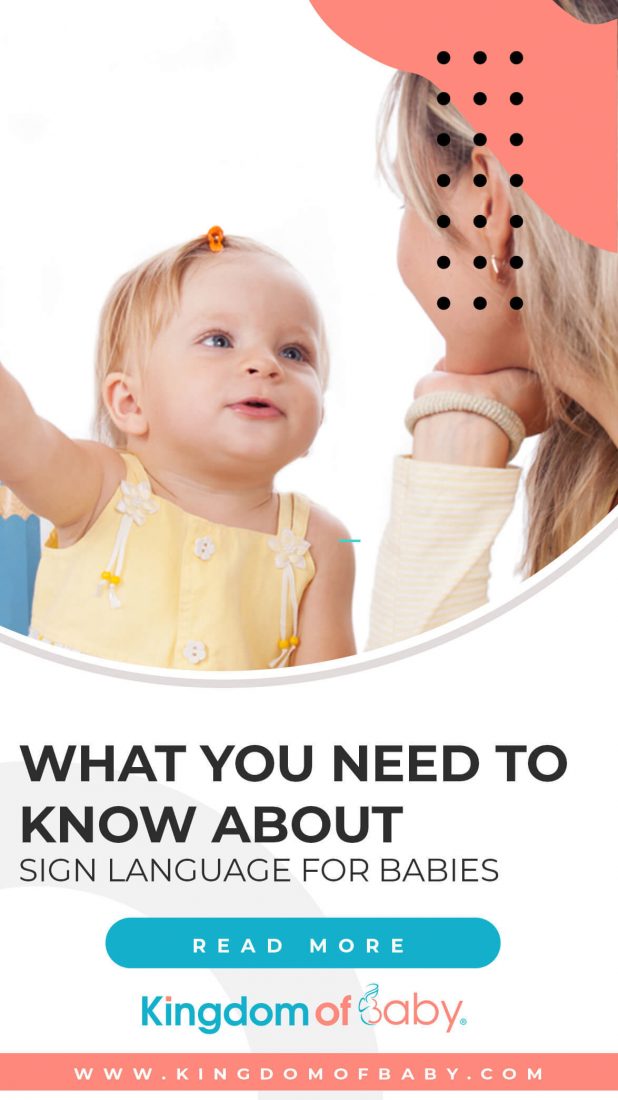
How do parents communicate with their babies? How do they know if the baby’s hungry and wants some milk? Babies usually cry to “tell” their parents something, but it could be hard to guess what the baby wants to say.
You may have probably heard of American Sign Language (ASL), but do you know that babies have their own sign language, too? Aside from crying or making a noise, babies use gestures to communicate with their parents or caregivers.
Just think about this. When a baby points to an object, the parent or caregiver can recognize this gesture as the baby’s attempt to communicate with them. Since the baby can’t talk yet, gestures help both the baby and the parent to communicate and understand each other.
What is Baby Sign Language?

Baby sign language means using simple gestures to communicate with babies. In her article “About Baby Signing”, Dr. Brenda Seal defined baby signing as the use of sign language, such as American Sign Language, but with modifications. The modified signs make it easier for the parent to teach them to their child, and for the baby to understand and remember them.
Teaching Baby Sign Language
When should you start teaching baby sign language? Experts say that you can start teaching sign language to your babies when they are between 4 to 6 months old. This is the time when babies become more aware of their surroundings so it’s a good time for them to learn gestures and other skills.
Here are some tips in teaching baby sign language:
-Keep signs simple and easy for the baby to remember.
Your baby is still in the early development stage so make your signs easy for them to imitate and remember. The simple signs may also benefit you because you don’t have to study really hard to learn the signs.
-Always say the word while making the sign.
When you start teaching the sign to your baby, you should say the word while making the sign at the same time. For example, say “Mom” while placing an open hand in front of your face and tapping your chin using your thumb.
-Repeat the gestures.

The key to teaching sign language to babies is to repeat the actions. Babies tend to remember the gestures when you do them twice or thrice while communicating, and when you use the gestures regularly.
-Be patient.
It’s not easy to teach babies new things, but you should never give up. You need a lot of patience as a parent, and you’ll need even more as you start teaching them to sign language. Don’t get frustrated when your baby seems to be distracted or can’t seem to easily remember the signs. Let them learn at their own pace.
Some Baby Signs to Know
Thinking about learning sign language for babies? You may want to consider the words that you commonly use.
Here are some common baby signs and how to make them:
-Hungry
Make a “C” shape using your hand. Your palm should face your body. Move your hand from your neck down to your stomach, as if food is going down to your stomach.
-Milk
Make a fist by closing your fingers. It will look as if you’re milking a cow. Hold it in front of your chest as if you’re holding a bottle.
-Water
Make a “W” using the three middle fingers of your hand. Then touch your chin using the index finger (from your “W” hand).
-Eat

Put the tips of the fingers of your hand together to form a point, and then bring that hand to your mouth, as if you’re eating.
-Bath
Form fists by closing your fingers and put your fists in front of your chest. Move your fists up and down, as if you’re washing or scrubbing your chest.
-Play
Form a “Y” with your fingers (your thumbs and pinkies should be extended while the three middle fingers should be closed) and then twist or swing your hands back and forth.
-Sleep
Put one open hand in front of your forehead, with your palm facing toward you. Form a fist as you draw your hand down to your chin with your eyes closed.
-Mom
Open your hand and spread your fingers. Tap your thumb to your chin several times.
-Dad
Similar to the sign for mom, open your hand and spread your fingers. Tap your thumb to your forehead several times.
-Done
With palms facing toward you, put your hands up. Then turn them repeatedly as if you’re showing someone that there’s nothing in your hands.
-More
Put your thumbs and fingers together to form 2 “O” shapes. Then touch the tips of your fingers on both hands, separate and then tap them together again. You can repeat the action several times.
-Bye
Hold your palm up next to your shoulder. Bend your fingers together repeatedly. The gesture is similar to how we usually wave goodbye.
Benefits of Teaching Baby Sign Language
Some parents believe that teaching a baby sign language is beneficial for the baby. Some studies have supported this belief; they discovered that babies who signed learned and developed their speaking skills at a faster rate compared to others.
Some findings also show that babies develop a higher IQ level. They learn more because of the actions and movements that they see every day.
Moreover, when babies know how to sign, they tend to cry less. It’s because they can already somewhat tell their mom or dad what they want through the gestures. They have fewer tantrums. Babies also get less “frustrated” because they are now able to communicate with their parents or caregivers.
As parents, sign language for babies can also help you better understand your child. Besides, it can be fun to teach your child something new and the whole learning process can also be an enjoyable experience for your baby. More importantly, the time that you spend interacting with your baby while teaching sign language can create a closer bond between you and your child.
Now that you know some information about sign language for babies, you may want to consider teaching the gestures to your precious one.
Read also:
- Baby Clapping: Teaching Your Child How to Wave, Clap, Point
- Help Understand your Baby by Learning these 7 Essential Baby Cues
- 13 Fun Things to Do with Your Baby: Every Month a New Thing to Do


